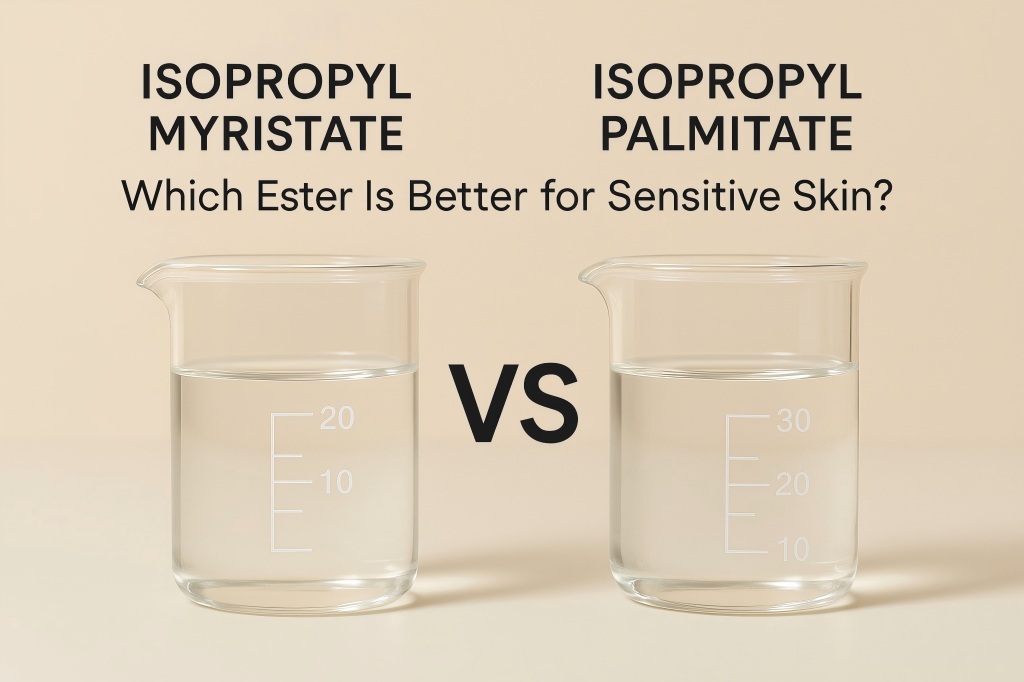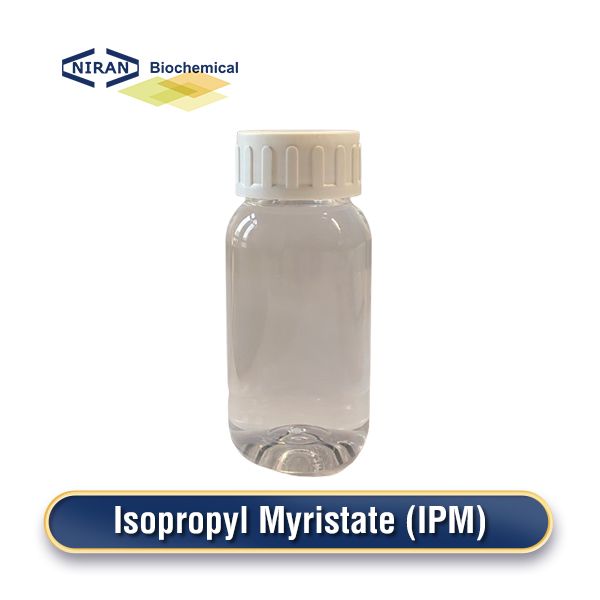Every ingredient counts in the skincare industry, particularly when creating formulas for sensitive skin. Isopropyl myristate (IPM) and isopropyl palmitate (IPP) are frequently taken into consideration as emollients and esters that are utilized to promote spreadability, distribute active ingredients, or improve skin feel.
However, which ester is better for skin that is more sensitive? To assist formulators, dermatologists, and customers in making wise choices, this article delves further into a comparison.
Why Esters Matter in Sensitive Skin Care
Esters are synthetic compounds formed by reacting alcohols with fatty acids. In skincare, they serve as emollients, solvents, or texture enhancers. Their inclusion in sensitive skin formulations is strategic: esters can provide a lightweight, non-greasy finish while improving the delivery of beneficial ingredients.
For sensitive skin, the goal is to maintain the skin barrier, avoid irritation, and minimize occlusion. Esters like IPM and IPP mimic the skin’s natural lipid profile, offering hydration without heavy oils. Yet, not all esters are equal in compatibility. Understanding how esters behave helps brands create formulations that soothe rather than stress delicate skin.
What Are Isopropyl Myristate and Isopropyl Palmitate?
Isopropyl Myristate (IPM)
Isopropyl alcohol and myristic acid, a 14-carbon saturated fatty acid, combine to generate the ester known as isopropyl myristate. It is transparent, low viscosity, and frequently used as a solvent and skin-conditioning agent.
IPM is well known for improving the sensory attributes of skincare and pharmaceutical products, particularly in creams, lotions, and topical drugs.
Isopropyl Palmitate (IPP)
Isopropyl palmitate is an ester of isopropyl alcohol and palmitic acid (a 16-carbon saturated fatty acid). IPP is slightly more viscous than IPM and offers a richer, velvety skin feel. It’s popular in emollient creams and sunscreens due to its softening properties and compatibility with various active ingredients.
Both are lipid-like, easily absorbed into the skin, and non-ionic, making them ideal candidates for sensitive skin formulations.
Key Functional Differences Between IPM and IPP
| Feature | Isopropyl Myristate (IPM) | Isopropyl Palmitate (IPP) |
| Fatty Acid Chain | Myristic (C14) | Palmitic (C16) |
| Molecular Weight | Lower | Slightly higher |
| Viscosity | Lower (more fluid) | Higher (richer texture) |
| Skin Feel | Lightweight, silky | Creamy, velvety |
| Absorption | Fast, dry finish | Slightly slower, soft finish |
| Comedogenicity | Low to moderate (debated) | Higher (may clog pores) |
| Solvent Ability | Excellent for actives | Moderate |
| Typical Use | Lotions, serums, topical meds | Creams, ointments, sunscreens |
Benefits of Isopropyl Myristate for Sensitive Skin
- Non-greasy hydration: IPM provides excellent emollient properties while delivering a dry touch. Sensitive skin often reacts poorly to greasy residues, so this ester is ideal for non-occlusive formulations.
- Enhances absorption: IPM acts as a penetration enhancer, helping deliver soothing actives like allantoin, bisabolol, and niacinamide deeper into the skin.
- Silky texture: It gives formulations a smooth, light feel, improving user compliance for sensitive skin regimens, which often require repeated application.
- Low viscosity: Its low molecular weight makes it perfect for serums or lightweight moisturizers aimed at fragile, irritation-prone skin types.
- Minimal odor and color: IPM’s neutrality makes it compatible with fragrance-free or low-irritant products typically preferred in sensitive skincare.
Benefits of Isopropyl Palmitate for Sensitive Skin
- Superior moisturization: IPP has a richer emollient profile, making it more suitable for very dry and flaky sensitive skin, especially in cold climates.
- Velvety finish: It leaves a soft after-feel, which helps reduce tactile discomfort in inflamed or peeling skin.
- Improves cream stability: IPP supports the overall formulation texture, helping create a rich, even spread in heavier creams designed for barrier repair.
- Reduces transepidermal water loss (TEWL): By reinforcing the skin’s lipid barrier, IPP helps trap moisture, reducing dryness that can trigger sensitivity flares.
- Blends well with actives: While not a strong solvent, IPP complements lipophilic active ingredients without causing degradation.
Drawbacks and Irritation Potential of Each Ester
IPM Drawbacks
- Potential irritant in high doses: Though generally well tolerated, excessive IPM may penetrate too deeply, increasing the risk of irritation from active ingredients.
- May dry skin over time: Its fast-absorbing nature can create a pseudo-dryness if not paired with deeper moisturizers.
- Incompatibility with some sensitive skin types: A few users report stinging or redness when using IPM-heavy products, especially on broken or reactive skin.
IPP Drawbacks
- Comedogenic issues: IPP’s comedogenic grade ranges from moderate to high. For sensitive skin types prone to acne, this could be a problem.
- Heavier texture: While good for dry skin, the richer film IPP leaves may feel suffocating for some, especially in humid climates.
- Longer absorption time: Slower absorption might interfere with layerability in multi-step routines, potentially leading to product pilling.
Side-by-Side Comparison Table
| Attribute | Isopropyl Myristate (IPM) | Isopropyl Palmitate (IPP) |
| Skin Type Compatibility | Normal, oily, combo, sensitive | Dry, sensitive, flaky |
| Comedogenicity | 2 (low to moderate) | 4 (moderate to high) |
| Sensory Finish | Light, dry, silky | Rich, soft, velvety |
| Moisturization Level | Moderate | High |
| Penetration Ability | Strong (acts as enhancer) | Mild |
| Risk of Irritation | Low, unless overused | Low, but can clog pores |
| Best Used In | Serums, lotions, acne creams | Creams, balms, sunscreens |
| Common Pairings | Actives like niacinamide | Occlusives like shea butter |
| Absorption Rate | Fast | Medium-slow |
| Ideal for Daily Use? | Yes | Yes, with caution for acne-prone skin |
Applications in Sensitive Skin Formulations
Both IPM and IPP are widely used in cosmetics tailored for delicate or reactive skin types. Here’s how each is applied:
Isopropyl Myristate Applications:
- Lightweight moisturizers: Often combined with humectants for sensitive-oily skin.
- Topical treatments: Delivers actives like corticosteroids or azelaic acid in medicated creams.
- Cleansers: Used in non-foaming, balm-based cleansers where gentle removal of dirt and makeup is key.
- Hair care: Applied in anti-dandruff and scalp treatments to deliver actives without oil buildup.
Isopropyl Palmitate Applications:
- Barrier repair creams: Employed in products designed for eczema, psoriasis, or atopic dermatitis.
- Rich night creams: Offers lasting emolliency throughout the sleep cycle without frequent reapplication.
- Sunscreens: Provides a spreadable base that helps disperse UV filters evenly across sensitive skin.
- Lip balms and ointments: Softens chapped lips or dry spots prone to irritation.
Regulatory and Safety Considerations
Both esters are considered safe for use in cosmetic and pharmaceutical products globally:
- EU: Approved under the EU Cosmetics Regulation (EC) No 1223/2009. No restrictions for concentration, but safety evaluations are necessary for final products.
- US: FDA-approved for topical use and classified as GRAS (Generally Recognized as Safe). Listed in the Inactive Ingredient Database for drug formulations.
- Asia-Pacific: Approved for cosmetic use in Japan, Korea, China, and ASEAN countries. Subject to purity and contaminant testing under national guidelines.
Notably, for sensitive skin, formulators must verify that raw materials are low in residual solvents and tested for skin sensitization.
Formulation Tips for Sensitive Skin Products
- Pair with humectants: Use IPM or IPP alongside glycerin, hyaluronic acid, or panthenol to balance hydration levels.
- Choose complementary emulsifiers: Opt for mild, non-ionic emulsifiers to maintain barrier integrity.
- Avoid overuse: Limit ester content to <5% for leave-on sensitive skin products to prevent barrier disruption.
- Use fragrance-free systems: Both esters are compatible with fragrance-free formulations, reducing the chance of allergic reactions.
- Patch test formulations: Especially for IPP, which can be comedogenic on sensitive-acneic skin.
- Stability testing: Check for pH shifts and separation over time, especially when using IPM in active-rich formulations.
Final Verdict: Which One Is Better for Sensitive Skin?
The response is contingent upon the particular requirements of the person with sensitive skin.
- Choose Isopropyl Myristate if the goal is fast absorption, lightweight feel, enhanced delivery of active ingredients, or compatibility with acne-prone sensitive skin.
- Choose Isopropyl Palmitate for rich moisturization, barrier repair, or use in drier climates—provided the user isn’t prone to clogged pores.


